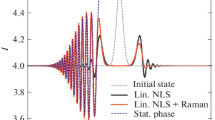Abstract
Self-steepening of optical pulses has been well described in the literature (De Martini et al., 1967; Marburger, 1975) and has been invoked to explain certain cases of spectral superbroadening (Yang and Shen, 1984). For intense optical pulses the refractive index depends on the intensity. Thus, the peak of the pulse travels at a speed different from that of the leading and trailing edges, so that ultimately the pulse tries to form a shock at the trailing edge if n 2 is positive or on the leading edge if n 2 is negative. A very similar thing occurs in fluid mechanics. However, all fluids exhibit viscosity and heat flow and these effects combine to prevent the formation of a truly discontinuous shock; they give the final shock structure, which has finite thickness and a definite shape. In the optical case, dispersion will play an analogous role; it brings the process of self-steepening to an end before a true discontinuity can form. It is for this last reason that we feel it to be imperative to include the effects of dispersion in our present study of self-steepening.
Access this chapter
Tax calculation will be finalised at checkout
Purchases are for personal use only
Preview
Unable to display preview. Download preview PDF.
Similar content being viewed by others
References
American Institute of Physics Handbook, 2nd ed. (1963) McGraw-Hill, New York. See p. 6–13 for dispersion data.
Bespalov, V.I. and V.I. Talanov (1966) Zh. Eksp. Teor. Fiz. Pis’ma 3, 307–310 (June 15 ).
Boling, N.J., A.J. Glass, and A. Owyoung (1978) IEEE Jour. Quant. Electronics, QE-14, 601 (August).
DeMartini, F., C.H. Townes, T.K. Gustafson, and P.L. Kelley (1967) Phys. Rev. 164, 312.
Hasegawa, A. and F. Tappert (1973) Appl. Phys. Lett. 23 (No. 4 ), 171 (August 15).
Kaup, D.J. and A.C. Newell (1978) J. Math. Phys. 19 (No. 4 ), 798 (April).
Marburger, J.H. (1975) In Progress in Quantum Electronics, J.H. Sanders and S. Stenholm, eds., vol. 4, part 1, p. 35. Pergamon, New York.
Suydam, B.R. (1973) Self focusing of very powerful laser beams. In Laser Induced Damage in Optical Materials: 1973, A.J. Glass and A.H. Guenther, eds. NBS Special Publication 387.
Whitham, G.B. (1974) Linear and Nonlinear Waves,chapters 1 and 3. Wiley, New York.
Yang, G. and Y.R. Shen (1984) Opt. Lett. 9, 510.
Zakharov, V.E. and A.B. Shabat (1972) Sov. Phys. JETP 34 (No. 1), 62.
Editor information
Editors and Affiliations
Rights and permissions
Copyright information
© 1989 Springer Science+Business Media New York
About this chapter
Cite this chapter
Suydam, B.R. (1989). Self-Steepening of Optical Pulses. In: Alfano, R.R. (eds) The Supercontinuum Laser Source. Springer, New York, NY. https://doi.org/10.1007/978-1-4757-2070-9_6
Download citation
DOI: https://doi.org/10.1007/978-1-4757-2070-9_6
Publisher Name: Springer, New York, NY
Print ISBN: 978-1-4757-2072-3
Online ISBN: 978-1-4757-2070-9
eBook Packages: Springer Book Archive




